As an Amazon Associate, I earn from qualifying purchases.
An easy step-by-step tutorial on Canning Peaches. This recipe for how to preserve peaches is perfect for beginners and experienced canners alike. Instructions include low-sugar and no-sugar options.

Peaches are one of the easiest fruits to can. Sure, you have to peel them, but that can be accomplished fairly easily.
Even better, I’m going to teach you how to make canned peaches in light syrup, so you can actually taste the fruit and not just sugar. Need no-added-sugar options? We’ve got those too!
And if you decided that peach preservation is just not for you, check out our Peach Freezer Jam, Peach Preserves, Homemade Peach Ice Cream, Peach Syrup, Drying Peaches, Peach Compote, tutorial on How to Freeze Peaches, and our Ginger Beer Mocktail. All use delicious fresh peaches without canning.
Canning Equipment List
Check out this in-depth post for a complete list of canning supplies.
- Peaches! You’ll need about 17 lbs per 7 quarts. You can always can fewer jars if you only have a handful of peaches.
- At least two large bowls. You can never have enough bowls when canning.
- A large pot of water for blanching the fruit and a medium pot for syrup
- Canner: water bath canner, a pressure canner (which can double as a water bath canner), or even a huge stockpot with a rack in the bottom.
- Canning tongs/jar lifter
- Jars – quarts or pints.
- New, clean canning lids
- Canning rings
- Wide mouth funnel
- Ice
- Sugar, honey, or juice
- lemon juice or citric acid
- Paring knife
- Cutting board
- Slotted spoon
- Ladle
- Butter knife or plastic chopstick
- Comfortable shoes. Don’t do this barefoot. Your back will hate you.
- Clean washcloths and at least one thick clean towel.
How to Can Peaches
*I’ll walk you through it here with some photos and tips, and you’ll also find a printable recipe card at the bottom of the post with exact measurements, etc. You can also click “jump to recipe” to skip down.
CANNING PREP
Prepare your water bath canner by filling it with water. You need to have enough water to cover the jars by 1 inch once the water is boiling.
Set the canner on the stove. Turn the burner to high. Once it reaches a boil, reduce it to a simmer. You want to keep the water hot so that everything is ready when the fruit is.
Wash and clean your jars. You’ll want to keep them warm to avoid having them crack when placed in the canner. You can fill them with hot water, or place them on a tray in the oven at 170˚F.
Wash your lids and set them aside in a clean place. You no longer need to simmer lids in water to keep them sterile. Woot!
Wash your fruit. I just run them under water and rub my hands on them to give the outside a scrub. Use a paring knife and cut the peach around the middle to separate it.

Remove the pit
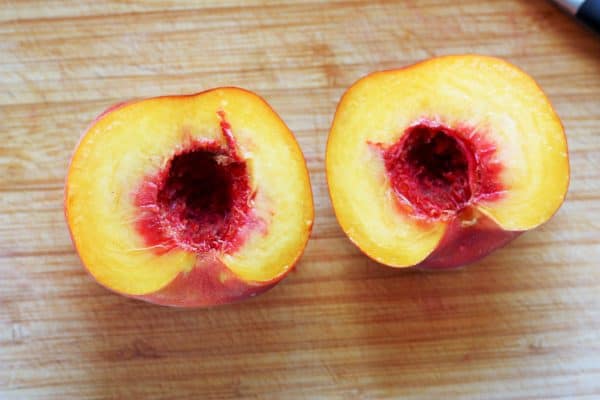
Put the halves in a large bowl of water treated with lemon juice or citric acid.
Blanching Peaches
Add one layer of peaches at a time to a pot of boiling water for about 60 seconds. Once you can see the skin starting to come away from the flesh, it’s time to take them out.
Remove using a slotted spoon and place in an ice bath for 1 minute.
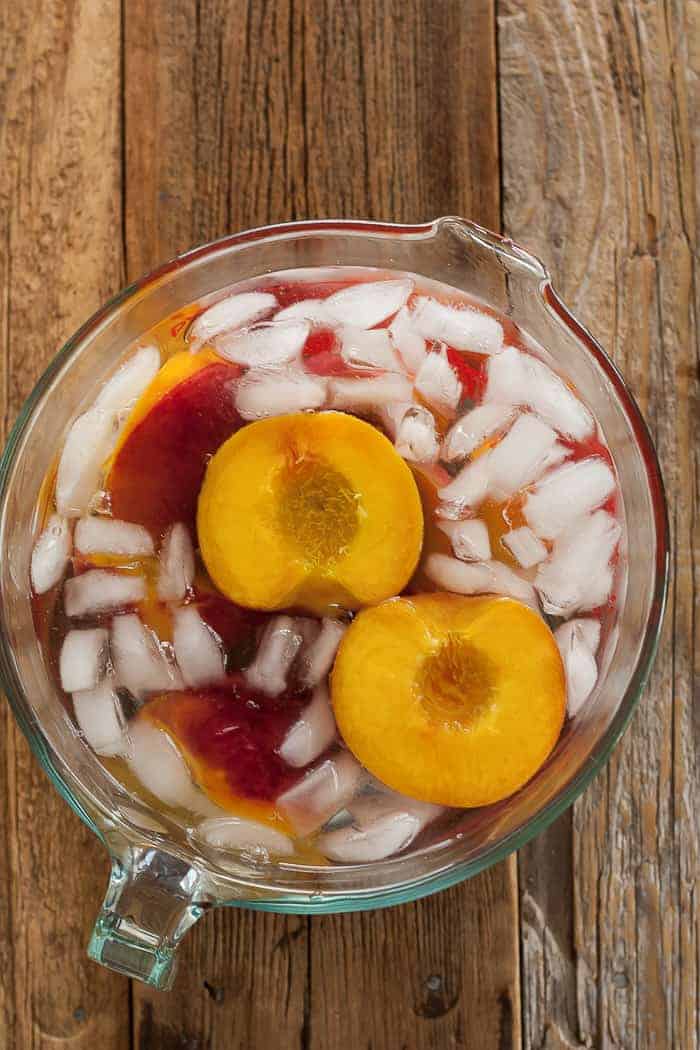
Use the slotted spoon to remove the peaches from the ice bath. Grab one and gently peel the skin back.
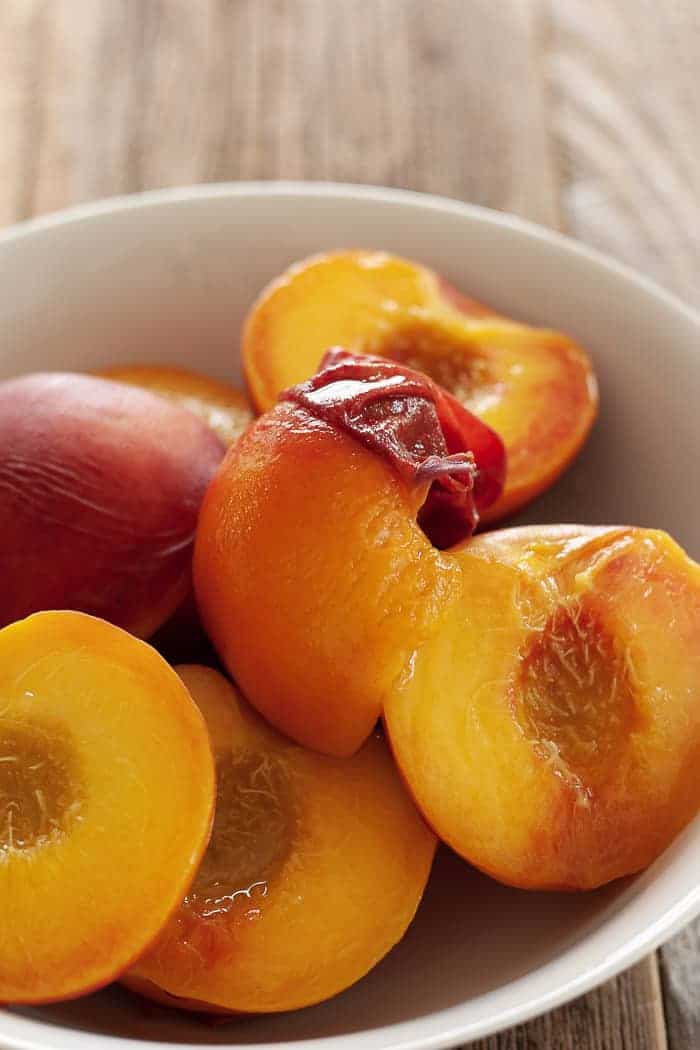
Syrups for Canning Peaches
If you prefer a no-sugar option, peaches can be canned using only water. But if you plan to can your peaches with sweetener, you can use sugar, honey, or fruit juice (apple or white grape). You’ll also want to decide how sweet you want the syrup to be.
In a medium-sized pot, combine your sugar/honey/or juice, and water to create the syrup. See the cheatsheet below as a guideline for making syrup:
Syrups for Canning
| Syrups for Canning | ||||
| Type of Syrup | Sweetener | Amount of Sweetener | Water | Yield |
| Very light | Sugar | 1 cup | 6 cups | 5 3/4 cups |
| Light | Sugar | 2 1/4 cups | 5 1/4 cups | 6 1/2 cups |
| Medium | Sugar | 3 1/4 cups | 5 cups | 7 cups |
| Heavy | Sugar | 4 cups | 5 cups | 7 cups |
| Honey | Honey | 1 cup | 4 cups | 4 1/4 cups |
| Juice | Apple or white juice concentrate | 1 1/2 cups | 4 1/2 cups | 6 cups |
| *Source: National Center For Home Food Preservation | ||||
Pro tip: if you plan to process multiple batches of peaches in a day, make the syrup and transfer it to a slower cooker set to “high”. This will keep the syrup hot while freeing up space on your stove.
Raw Pack For Canning Peaches
Raw packing simply means placing the peeled peaches in the jars without pre-cooking them, filling the jars with hot syrup, and processing them in the canner.
If you are canning your peaches without additional added sugar (sugar, honey, fruit juice), you must hot pack the fruit.
Raw packing is much faster than then a hot packing process, but there are some drawbacks. No matter how well you pack the jars, the density of the fruit will change during their time in the canner.
This often leads to something called “fruit float” in which the peaches will float to the top of the jar, leaving all syrup on the bottom. There is nothing wrong with fruit float as long as your jars are still sealed.
You’ll find this when you’re canning pears, canning apricots, and canning whole tomatoes as well.
To raw pack the peaches, add the fruit cavity-side down (where the pit was) to your sanitized and warm canning jars. This is easiest done with a fork. Repeat with other peach halves until you have filled the jar. Then, ladle hot syrup over the top of the peaches. Pro tip: depending on the size of the fruit, each quart will fit about 3-3.5 peaches.
Hot Pack For Canning Peaches
Hot packing involves cooking the peaches briefly in hot syrup before packing the peaches into jars for canning.
You’ll want to boil the peach halves in the canning syrup for about 2 minutes and then add them to your jars, ladling more hot syrup over the top.
The benefits of hot packing are that you typically can fit more fruit per jar, and the near elimination of fruit float.
Canning The Peaches
At this point, return your water in the canner back to a rolling boil.
Using a canning funnel, ladle hot syrup into the jars, leaving 1/2 inch headspace. Headspace is the distance between the top of the food and the top of the jar. You may need to use a spoon to gently smoosh down the fruit a bit.
Using a long utensil (I prefer a plastic chopstick), remove all the air bubbles from the jar. Clean the rim of the jar very well with a hot damp rag. Place a clean lid on the jar. Add a ring, and tighten to fingertip tight.
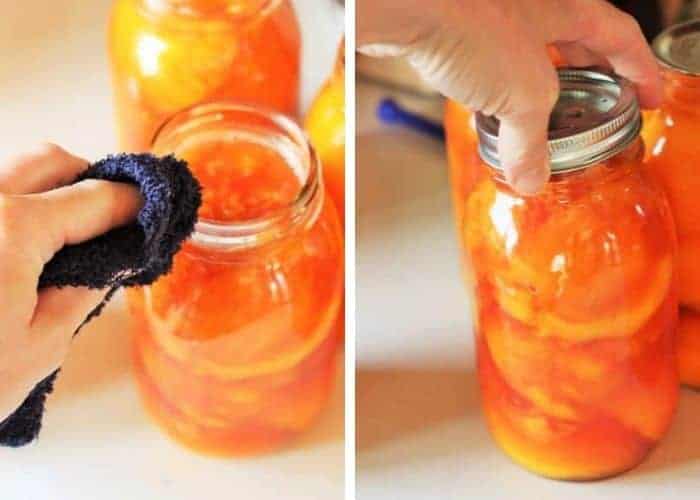
Using canning tongs, carefully place your jars in the canner. Put the lid on. Processing times will vary based on altitude. See the chart below.
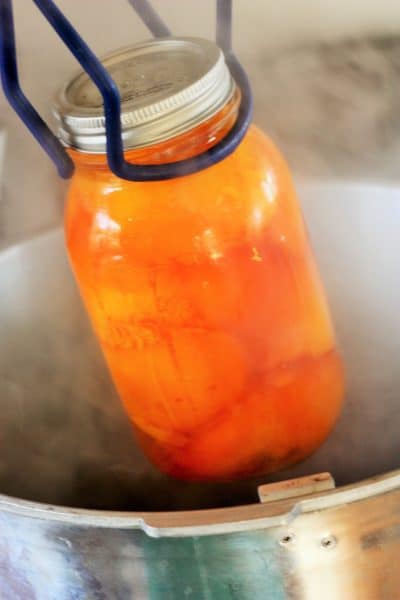
PROCESSING TIME FOR Canning Peaches
Pro tip: the water must return to a boil in the canner before you can start the timer.
Processing Time for Peaches
| Processing Time for Peaches | |||||
| Process Times at Altitudes of: | |||||
| Style of Pack | Jar Size | 0-1,000 ft | 1,001-3,000 ft | 3,001-6,000 ft | Aove 6,000 ft |
| Hot | Pints | 20 min | 25 min | 30 min | 35 min |
| Quarts | 25 min | 30 min | 35 min | 40 min | |
| Raw | Pints | 25 min | 30 min | 35 min | 40 min |
| Quarts | 30 min | 35 min | 40 min | 45 min | |
| *Source: National Center For Home Food Preservation | |||||
Once the jars have been processed for the appropriate amount of time, remove the canner from the burner, wearing oven mitts carefully take off the lid of the canner, and allow it to sit for 5 minutes. Pro tip: I tend to just slide the canner into the middle of my stove, as it weighs a ton.
Carefully remove the jars with canning tongs, and place them on a thick towel in a place where they can be undisturbed for 12 hours.
The lids will likely start to pop within 20-30 minutes of being removed from the water. That popping sound is music to your ears, as it tells you that everything has been sealed. It’s a reward for all your work!
After the jars have rested for about 12 hours, press down in the middle of each lid. If it “gives” at all, the jar didn’t seal. Either enjoy it that day, put it in the fridge, or reprocess it.
Pressure Canning Peaches
If you prefer to pressure can your peaches, follow the prep and packing process above and the canning process below.
Add 3 quarts of water to your pressure canner and put it on a burner set to high. Make sure there is a canning rack in the bottom of the canner.
Using canning tongs, gently place the jars in the canner. Lock the lid. Soon, steam will start coming through the vent pipe (I call it the steam chimney).
Allow the steam to pass through for about 10 minutes. Then put the pressure regulator (I call it the chimney cap) on top. (see the 4 photo grid below for a visual of this process step by step)
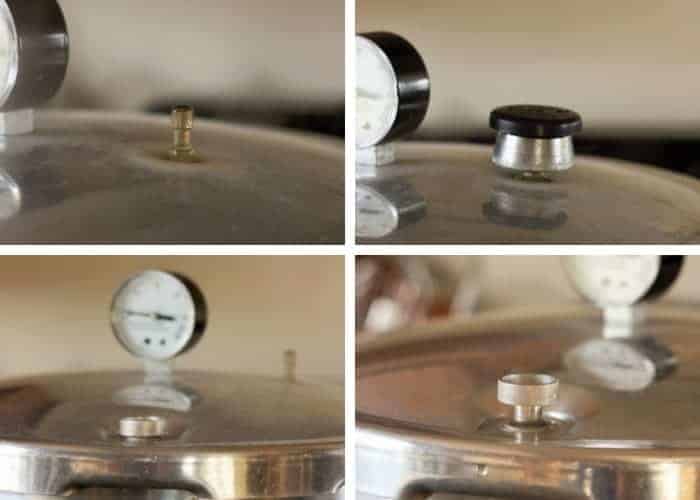
Pretty soon, the air vent will pop up. That is a sign that you’re starting to build pressure inside the canner (get excited. This is happening!). Processing times will vary based on altitude. See the charts below.
Pressure Canning Peaches in a Dial-Gauge Pressure Canner
| Canner Pressure (PSI) at Altitudes of | ||||||
| Style of Pack | Jar Size | Processing Time | 0-2,000 ft | 2,001-4,000 ft | 4,001-6,000 ft | 6,001-8,000 ft |
| Hot or Raw | Pints or Quarts | 10 min | 6 lbs | 7 lbs | 8 lbs | 9 lbs |
| *Source: National Center For Home Food Preservation | ||||||
Processing Time for Peaches in a Weighted-Gauge Pressure Canner
| Canner Pressure (PSI) at Altitudes of: | ||||
| Style of Pack | Jar Size | Processing Time | 0-1,000 ft | Above 1,001 ft |
| Hot or Raw | Pints or Quarts | 10 min | 5 lb | 10 lb |
| *Source: National Center For Home Food Preservation | ||||
When the dial gauge reaches the appropriate PSI, reduce the burner temp to medium, and start your timer. The pressure must stay at the PSA or (a little bit) above for the duration of the cooking time. You’ll likely need to adjust the temp on the burner a few times depending on your stove.
When the time is up, remove the canner from the burner and allow it to sit until you hear a distinctive “click” of the air vent dropping. Remove the pressure regulator and carefully remove the lid of the canner (Pro tip: I always use oven mitts when I take the lid off because the steam is super hot).
Let the jars sit for 5 minutes in the canner with the canner lid off and then lift them out with canning tongs. Pro tip: allowing the jars to sit in the canner with the canner lid off can help reduce the siphoning of liquid in your jars.
Place hot jars on a towel where they can sit undisturbed for 12 hours.
After a few hours, to check for sealing, gently press down in the middle of the lid. If the lid has no give, it’s sealed. If you can press the lid in and it pops a bit, your jars are not sealed.
STORAGE FOR HOME CANNED Peaches
Once the jars have sealed, remove the rings. Label and store sealed jars in a cool (best results are 50-70˚F) dark place for up to 12-18 months.
If you have the space available, do not stack the jars on top of each other more than two jars high.
Frequently Asked Questions
Most varieties will work for canning. You’ll find peaches come in two main types:
Freestone – when cut in half, the peach will separate easily from the pit. These make canning so much easier!
Cling – the peach flesh will “cling” to the pit, making it very challenging to cut them in half. If you use cling peaches for canning, you will likely be canning peach slices instead of peach halves. For help with tackling the task of working with the cling variety, check out this post on How to Cut a Peach.
At this time, the National Center for Home Food Preservation does not recommend you can white peaches. The ph levels vary too much, making them generally unsafe to can. It is recommended you freeze white peaches instead of canning them.
Yes. That being said, sugar is used in canning for flavor, preservation, and color. Sweet food generally tastes better, keeps longer, and the color of the food stays bright and fresh.
Peaches have enough natural sugar and don’t need any sweetener added while canning to be considered safe. But your final product may look a bit different and have a shorter shelf life.
Personally, I walk the line between no sugar and low sugar for canning peaches and canning pears.
Yes, you are able to can peaches with honey.
Please note, if you’re using raw honey, any of the beneficial properties will be killed during the heating process. It’s more affordable to use regular honey for canning.
Yes, you are able to can peaches with fruit juice.
You’ll need 48 oz of juice per 4 pounds of peaches using a hot pack process. Using frozen concentrated apple or white grape juice is a great and easy substitution for refined sugar syrup.
Use one can of thawed concentrate mixed with three cans of water.
They are safe to eat as soon as the jars have cooled!
Unlike a project like Refrigerator Dilly Beans, home-canned peaches don’t need to rest before they’re ready to enjoy. Dig in!
Help! Why Are My Jars Leaking Juice?
If you find that juice has leaked out after they have sealed, you have experienced a common canning issue called siphoning. It happens to the best of us!
Siphoning is typically caused by not allowing the jars to rest in the canner after they have finished processing. In the directions above, you’ll see that I recommend you remove the canner from the burner, remove the lid, and let it sit for 5 minutes.
This is important as it allows the jars time to rest before being allowed to cool on the counter. Doing this process will significantly cut down on siphoning.
If you have siphoning in your jars, follow these steps:
- Check – are the lids still sealed?
- Look – have you lost less than half of the amount of liquid in the jar?
- Examine – does the fruit look fresh with bright colors?
If the answer to the above three steps is “yes!”, then they are safe to eat. If you lost quite a bit of syrup, the uncovered fruit will turn color more quickly. Plan to eat those jars first.
What if my jars don’t seal?
If you’ve correctly processed your fruit, and the lids still didn’t seal, you can reprocess them.
Double-check to make sure there are no:
- Chips in the rim of the jar
- Dried syrup or bits of peach on the rim (anything between the rim and the lid may prevent a seal.
Best practices would involve using brand-new lids for reprocessing. Set aside the old lids to use for dry storage (related: Pantry Essentials for the Home Cook).
If the jars don’t seal on the second attempt, you likely have a bad batch of lids, or your canning process has a step missing. Email me and we’ll try to troubleshoot what is going on.
For unsealed jars, you can place them in the fridge. Eat the fruit within three weeks.
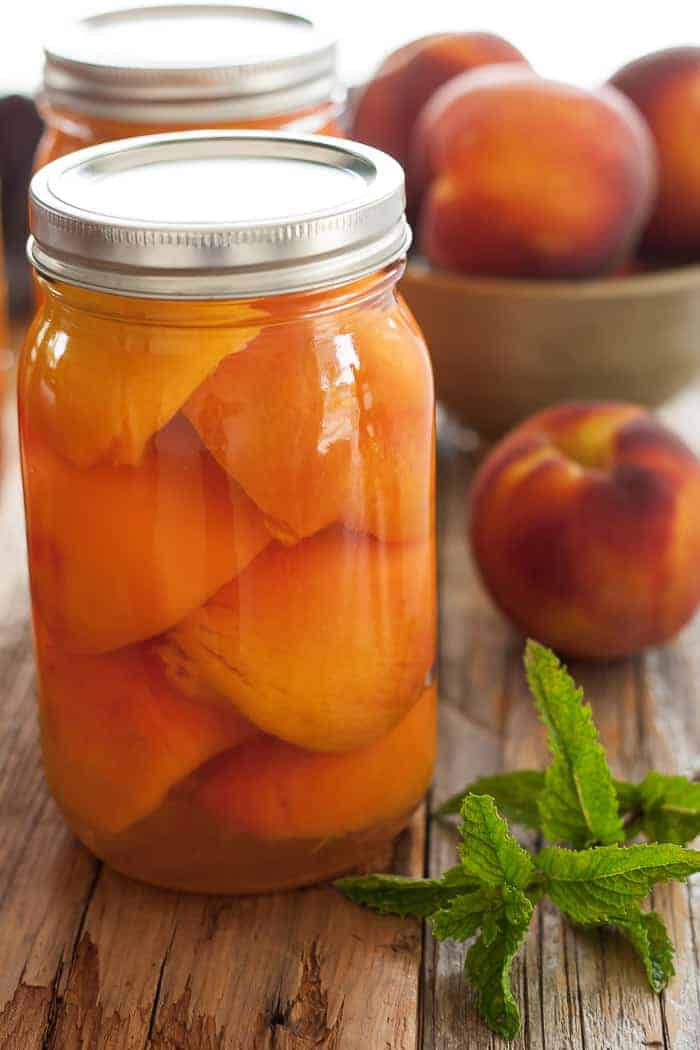
Can I make canned peach slices?
Yes! If you’d prefer to cut your fruit into slices, that is absolutely fine. Think about how you plan to use them after canning. Do you want to eat them as is? If so, halved peaches will be the easiest and fastest way to can them.
If you use them in crisps/crumbles, other desserts, or yogurt (related: Easy Instant Pot Yogurt) slices make a lot of sense!
Pro tip: with canning peach slices, you’ll need to put a bit more effort into removing bubbles from the jars. There will be more opportunities for “pockets” to occur in the jars, and those bubbles need to be removed for safety.
More canning recipes you’ll love:
Check out my entire category of Canning recipes for more ideas and inspiration.
Canning Peaches {How to Can Peaches}
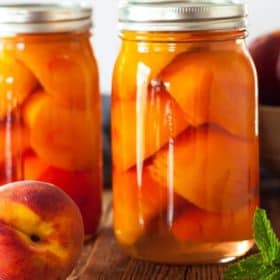
Equipment
Ingredients
- 17 lbs peaches
- 1/4 cup lemon juice
- 6 cups water {+more for the canner}
- 1 1/2 cups sugar
- ice
Instructions
Canning Prep
- Prepare your water bath canner by filling it with water. You just need to have enough water to cover the jars by 1 inch once the water is boiling.
- Set the canner on the stove. Turn the burner to high. Once it reaches a boil, reduce it to simmer. You want to keep the water hot so that everything is ready when the peaches are.
- Wash and sanitize your jars. You’ll want to keep them warm to avoid having them crack when placed in the canner. You can fill them with hot water, or place them on a tray in the oven at 170F.
- Wash your lids and set aside in clean place.
- Use a paring knife and cut the peach around the middle to separate. Remove the pit. Put the halves in a large bowl of water treated with lemon juice (~1/4 cup) or citric acid (1 tbsp).17 lbs peaches, 1/4 cup lemon juice
Blanching Peaches
- Fill a large mixing bowl with ice water. Set aside.ice
- Add one layer of peaches at a time to a pot of boiling water for about 60 seconds.
- Remove using a slotted spoon and place in the ice water for 1 minute.
- Use the slotted spoon to remove the peach halves from the ice bath. Grab one of the peaches and gently peel the skin back.
Canning Peaches
- Combine water and sugar in a medium saucepan. Bring to a low boil and fully dissolve the sugar. See the chart in the post above for different levels of syrup.6 cups water, 1 1/2 cups sugar
- (Hot Pack Method) Once the syrup is boiling, add the peach halves one layer at a time (a canning term that means don’t totally fill the pot) and heat for 2 minutes.
- (Hot pack option) Using a fork and canning funnel, grab the now softened peaches, add the peach halves, one at a time, and put them cavity-side (where the pit was) down in the canning jar.
- (Hot pack option) Repeat with other peach halves until you have filled the jar. Pro tip: depending on the size of the peaches, each quart will fit about 3-3.5 peaches.
- (Hot pack option) Using a canning funnel, carefully ladle hot syrup into the jars, leaving 1/2 inch of headspace.
- (Raw pack option) Using a fork and canning funnel, place peaches cavity-side down in the canning jar.
- (Raw Pack Option) Using a canning funnel and a ladle, fill each jar with hot syrup or water, leaving 1/2 inch of headspace. Headspace is the distance between the top of the food and the top of the jar.
- At this point, return your water in the canner back to a rolling boil.
- Using a long utensil (I prefer a plastic chopstick), remove all the air bubbles from the jar.
- Clean the rim of the jar very well with a hot damp rag.
- Place a clean lid on the jar. Add a ring, and tighten to fingertip tight.
- Using canning tongs, gently place your jars in the canner. Put the lid on, and set your timer. Pro tip: the water must return to a boil in the canner before you can start the timer.
- Process HOT PACK pints and quarts based on the elevation guide below:*0-1,000 ft – Pints =20 min Quarts =25 min*1,001-3,000 ft – Pints =25 min Quarts =30 min*3,001-6,000 ft – Pints =30 min Quarts =35 min*6,000 ft+ – Pints =35 min Quarts =40 min
- Process RAW PACK pints and quarts based on the elevation guide below:*0-1,000 ft – Pints =25 min Quarts =30 min*1,001-3,000 ft – Pints =30 min Quarts =35 min*3,001-6,000 ft – Pints =35 min Quarts =40 min6,000 ft+ – Pints =40 min Quarts =45 min
- Once the peaches have processed for the appropriate amount of time, remove the canner from the burner, and carefully remove the lid of the canner (Pro tip: use oven mitts to take the lid off because the steam is super hot).
- Using canning tongs, carefully remove the jars, and place them on a thick towel in a place where they can be undisturbed for 12 hours.
- After the jars have rested for about 12 hours, press down in the middle of each lid. If it "gives" at all, the jar didn't seal. Either enjoy it that day, put it in the fridge, or reprocess it.
Notes
- If you’re planning to can multiple batches of peaches all at once, I use my crockpot to create and keep the syrup hot. It frees up space on the stove.
- Once the jars have sealed, remove the rings. Label and store sealed jars in a cool (best results are 50-70˚F) dark place for up to 12-18 months.
Nutrition
Nutrition information is automatically calculated, so should only be used as an approximation.

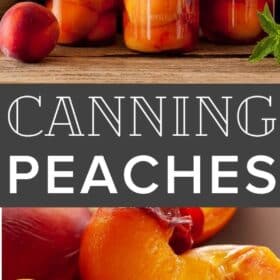
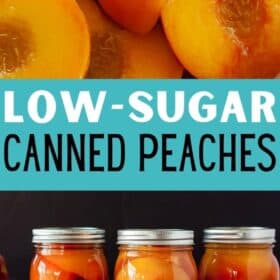
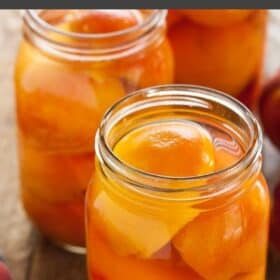
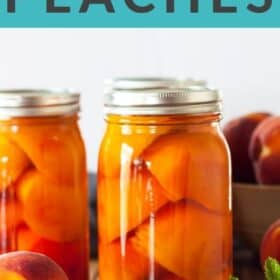
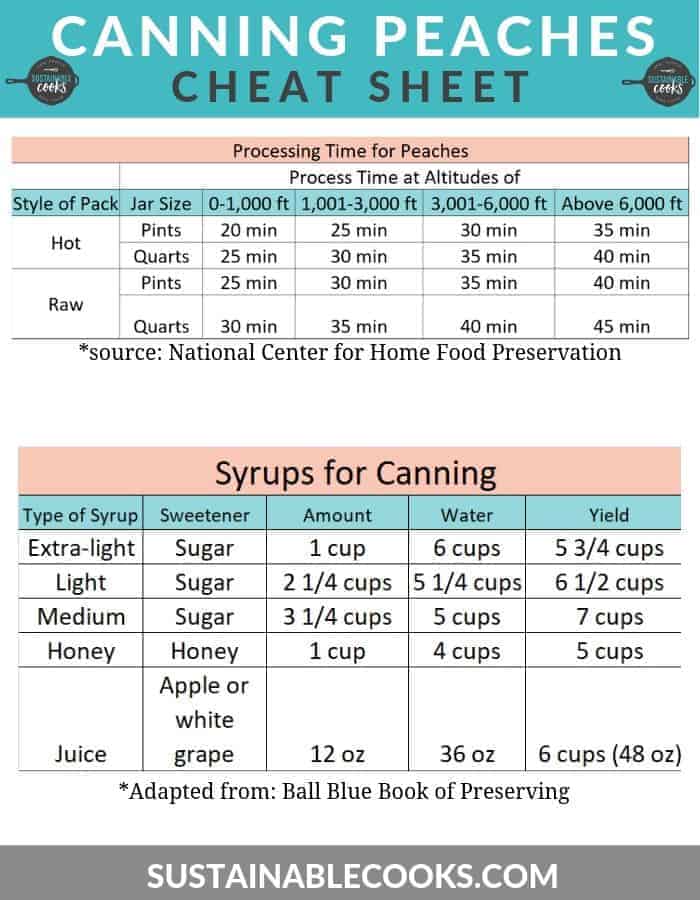
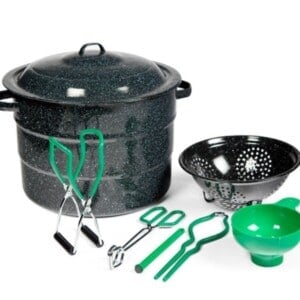
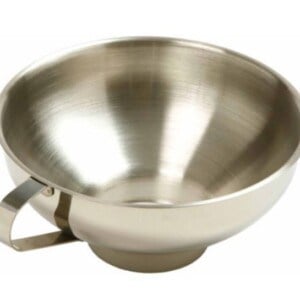
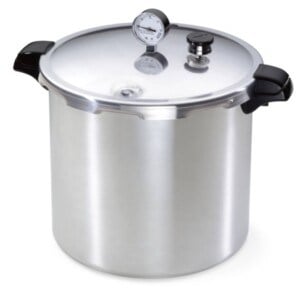
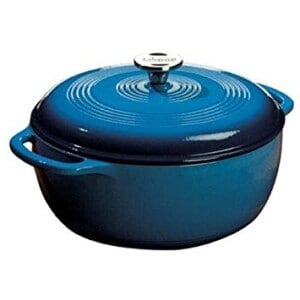

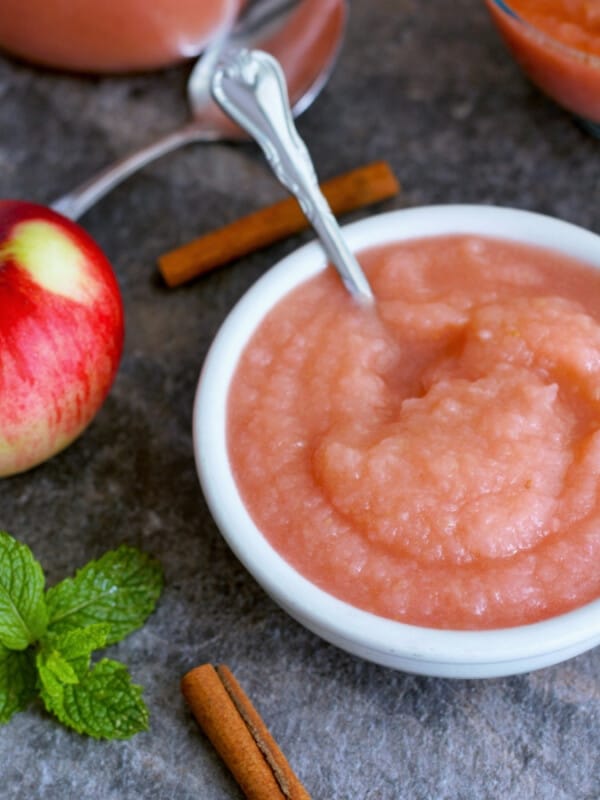
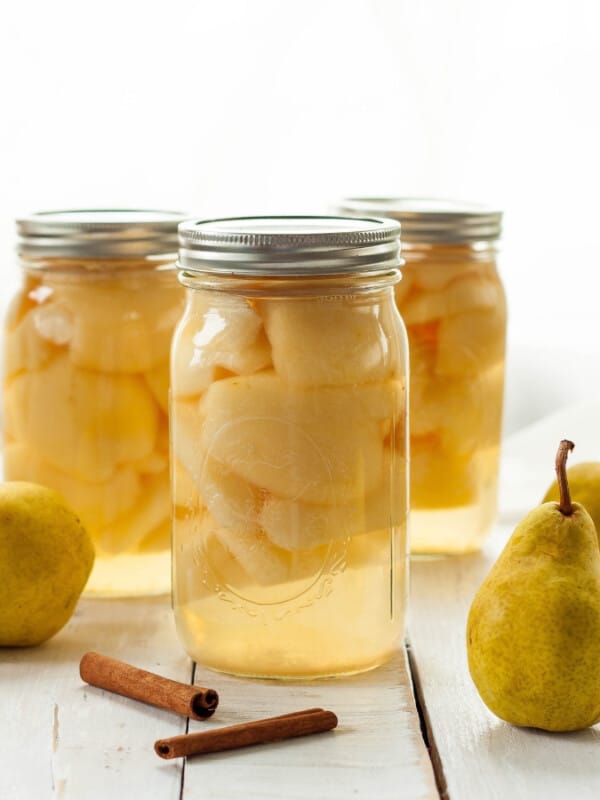
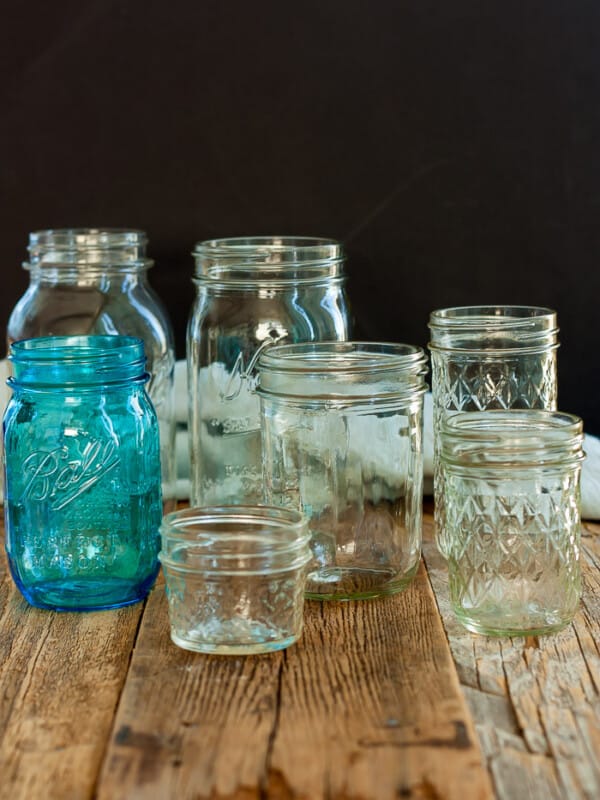
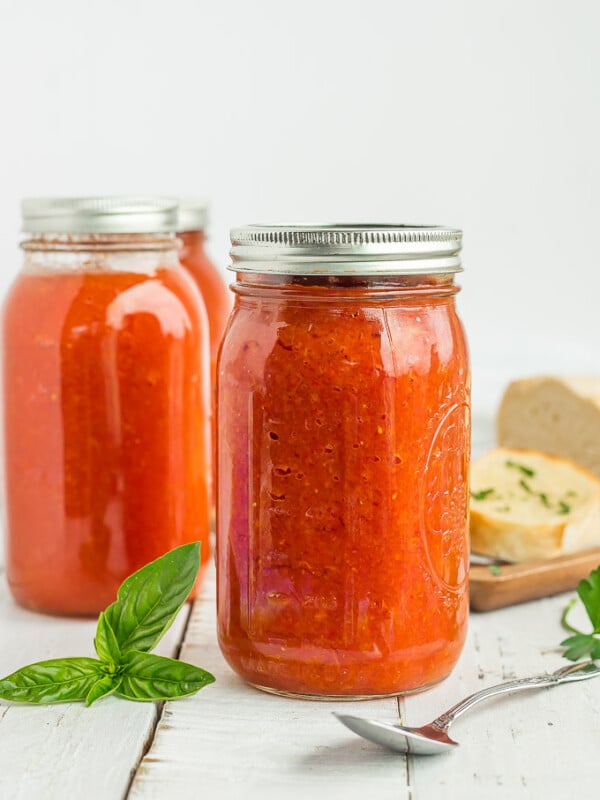
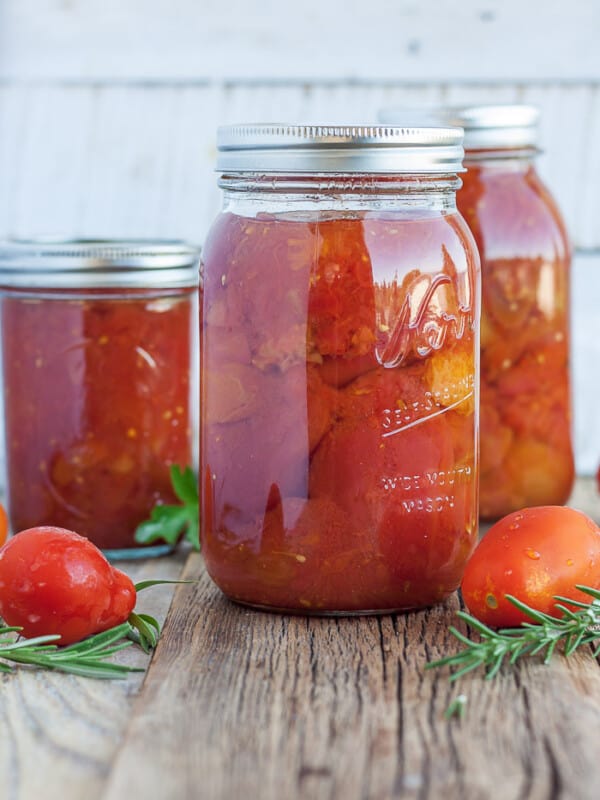
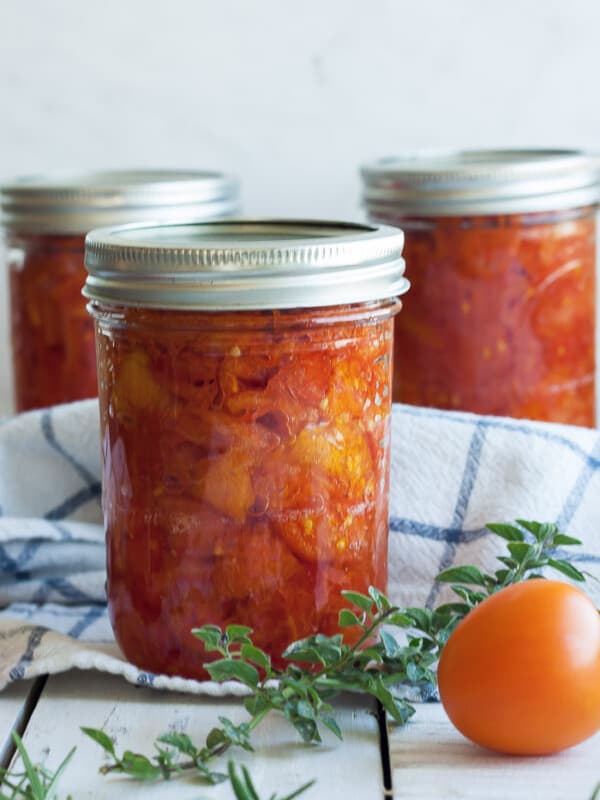






great article, thank you! First time canner here, just tried a batch of peaches, but my lids have not popped after cooling for over half an hour. Does that mean they definitely did not seal, or is the “press test” after 12 hours the true indicator they are sealed properly?
Rick, they may not make the popping sound (and sometimes I’m too busy cleaning up to hear it!). The press test is definitely the true indicator.
Anything special to know if you use those canning jars with the wire snap shut lids and a plastic type seal?
Is processing different?
Mike, I’d need to see a photo of what you’re talking about before I could advise. Do you mean the old-school type lids? Weck jars? There are very few jars like what you are describing that is considered safe anymore.
Just so you know all honey is raw, if you look on any honey bottle it should say pure honey. There is no difference.
Thanks! I wonder if that is a USDA labeling requirement for things sold nationally. We purchase local honey and I know Washington State has slightly different labeling requirements.
This is my 1st time canning. I wish I had a grandmother alive that could have shown and taught me how to can. And also answer questions I may have about it. I think I just ruined my1st batch of peaches. I did the hot method and I forgot to get air bubbles out before sealing. Do I need to pop and reseal? Also forgot lid was not on my water bath canner. I don’t know if I will do this again. It’s been a horrible experience with lots of crying.
Oh, Melissa, I feel your pain. The first time I canned it was a traditional batch of jam (so much sugar and SO much stirring) and I hated it so much I didn’t do it for another two years. Deep breaths.
The lid is required for it to be safe, otherwise, it is an outdated practice called “open kettle canning” which the USDA says is not safe. You can reprocess them in a closed water bath canner but my gut feeling is that they would become too mushy for your tastes.
If you have any questions/want to rage cry with me (I so get it), you can email me directly and we can troubleshoot what to do next.
I know there was a bit of confusion on some of this, but being a canner since I was a child (51 yrs) I knew just what to do. It’s been a long time since I canned peaches and wasn’t really sure if I was leaving out some of the process and hadn’t really planned on canning peaches, but this yr our local Produce stand friends have given me quite a few cases of peaches that they can’t put out on display. In return I give them some of my canning products. Thank you for sharing your recipes and I’m happy to say my peaches turned out beautiful.
Renee, I’m so glad it turned it out so well for you!
I am curious as to what you mean by a bit of confusion. I’ve refined this post over seven years to make sure it is as clear as possible. If you have suggestions on where it can be improved, please email me directly. I’d love to make sure it’s 100% straightforward for my readers.
I’m a little confused on the comment made about it taking longer in a pressure cooker canning process than a water bath. From the table it’s 20-30 min for a water bath and 10 min under pressure. I realize it takes time for the pressure cooker to come up to pressure, but I don’t understand the ‘word of warning’ point. It would seem to me it’s the same time to can regardless of water bath vs pressure cooker. Since I’m new at this, I’m just trying to understand the reason for the warning. I only have a pressure cooker and that made me hesitate over the instructions so that is why I’m asking about it. Thanks for the very detailed instructions. I’m hoping to try this canning process in the next few days.
P, it does take time to come to pressure but it also takes time to depressurize. If someone wants to can just 1 batch of peaches in a pressure canner, the timing is *about* the same as water bath. When you are canning multiple batches, pressure canning takes A LOT longer since you’re constantly waiting for it to come to pressure and depressurizing. The warning is to let you know it takes a lot more time.
That being said, I too only have a pressure canner. I still use it as a water bath canner by removing the dial gauge from the middle. It then works as a water bath canner.
Hi! These peaches look like they will be yummy!
Is it possible to substitute Monk Fruit sweetener for sugar in any of your jam recipes for canning?
Hi Kerry, I had to go into a bit of a rabbit hole to find an answer for you since I have never worked with Monkfruit before.
I couldn’t find anything on the National Center for Home Food Preservation or the Ball site, but I did find mention of it on the Pomona’s Pectin site. Pomona’s is the pectin I use for my jams since they will “gel” with little to no sugar. In this post down in the comments, you’ll find a Pomona employee noting that they have used Monkfruit with good results.
So, long story short, it looks like it is safe. 🙂
Sarah, My jars of peaches seem tightly sealed but I am worried as I never heard the “pop”. Is that a problem for preservation? Also the peaches did what I think is “float” to the top and some seem to be uncovered by the syrup. Is that also a problem?
Thanks, Judy
Hi Judy, if you push down on the middle of the lid is there any give? If not, they’re sealed! Some jars just don’t make the popping sound or perhaps you missed it (because cleaning up after canning is a six-hour job!).
The other thing is called “fruit float” and it’s totally normal. As long as the jars are sealed, it’s ok if some are above syrup. The peach on top will likely discolor after a few months but it will still be safe to eat. I just move those jars to the front of the shelf and make sure we eat them first.
Hi, I am confused about the amount of peaches to use. At one point you say 17 lbs for 7 quarts but elsewhere it says 3-3.5 peaches per quart. When I weighed out 17 pounds I had 35 peaches. That’s 5 per quart. Doing the math the other way, 17 lbs for 7 quarts means 2.4 lbs per quart. Make that ounces for ease and it’s not quite 39 ounces. Divide that by 3 to 3.5 and that comes to giant peaches, on average 11-13 ounces. Mine are about 7 +/- and the internet thinks a large peach is 6 ounces. Very confused! Can you clarify? Thanks for your post – I am looking forward to trying canning.
When you’re working with fresh produce, things get complicated, especially if you’re using homegrown vs farm-grown. The 17 lbs is an average as set by the National Center for Home Food Preservation. Each crop/source is different so it’s just a general starting point.
On average, I can fit 3-3.5 peaches from the farmer’s market into a quart. If you have big ones, it might be fewer. Small peaches might mean more. Just layer them in the jar like you see in the photos in the post and it will work out. 🙂
Why would you say it takes longer to pressure can then water bath can. That’s patently false. Both methods require water to come to boil or pressure. 10 minutes under 5 lbs for 10 minutes, or 25 minutes after boil starts. There seems to be a simple math problem here. Unless your using a giant pressure canner, there’s no comparison.
Valorie, you also need to take into account the time it takes to depressurize. Depending on the size of the canner, it can take 15-20 minutes before it is safe to remove the lid.
If you’re canning one batch and want to use the pressure canner, the math is about even. But it gets more cumbersome to pressure can multiple batches.
Whereas if you use the water bath method, you can start another batch almost as soon as you’ve finished the last batch (5 minutes resting time plus a few minutes to get back up to a rolling boiling). You’re not waiting for it to pressurize and depressurize each and every time.
Information for both options is provided to allow people to choose their preferred method.